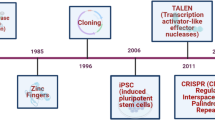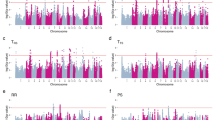Abstract
The apolipoprotein E (ApoE) gene is an important component of plasma lipoprotein, and Fas apoptosis inhibitory molecule (FAIM) is a novel anti-apoptotic gene. In this study, we researched and discussed seven genes in eight different tissues in Qinchuan cattle by quantitative Real-time PCR. The result of analysis showed that ApoE and FAIM 2 genes had a correlation with muscle and fat. PCR–RFLP was applied to analyze the genetic variations of the ApoE and FAIM 2 genes and verify the effect on growth and carcass traits in a total of 365 Qinchuan cattles. The result of haplotype analysis showed that nine different haplotypes were identified among the four SNPs in ApoE and FAIM 2 genes. The statistical analyses indicated that the four SNPs were significant association with growth and carcass traits (P < 0.05, N = 365); and the four SNPs were significant association between nine combined genotypes of candidate genes and growth and carcass traits. Taken together, our results provide the evidence that polymorphisms in candidate genes are associated with growth and carcass traits in Qinchuan cattle, and may be used as a possible candidate for marker-assisted selection and management in beef cattle breeding program.


Similar content being viewed by others
Abbreviations
- ApoE :
-
Apolipoprotein E
- FAIM :
-
Fas apoptosis inhibitory molecule
- PCR-RFLP:
-
Polymerase chain reaction–restriction fragment length polymorphism
- SNPs:
-
Single nucleotide polymorphisms
- PC:
-
Pheochromocytoma cell
- NGF:
-
Nerve growth factor
- FasL:
-
Fas/Fas ligand
- EST:
-
Expressed sequence tag
- LD:
-
Linkage disequilibrium
- He :
-
Heterozygosity
- Ho :
-
Homozygosity
- PIC :
-
Polymorphism information content
References
Mahley RW (1988) Apolipoprotein E: cholesterol transport protein with expanding role in cell biology. Science 240:622–630
Schachter F, Faure-Delanef L, Guenot F, Rouger H, Froguel P, Lesueur-Ginot L, Cohen D (1994) Genetic associations with human longevity at the ApoE and ACE loci. Nat Genet 6:29–32
Orchard S, Zhu W, Julian JRK, Hermjakob H, Apweiler R (2003) Further advances in the development of a data interchange standard for proteomics data. Proteomics 3:2065–2066
Das HK, McPherson J, Bruns GA, Karathanasis SK, Breslow JL (1985) Isolation, characterization, and mapping to chromosome 19 of the human apolipoprotein E gene. J Biol Chem 260:6240
Li SX, Gao P, Chen ZM, Zhang H, Li JQ (2010) The single nucleotide polymorphism of the porcine APOE Exon 4. Acta Agriculturae Universitatis Jiangxiensis 32:0647–0650
Marques-Vidal P, Bongard V, Ruidavets JB, Fauvel J, Perret B, Ferrieres J (2003) Effect of apolipoprotein E alleles and angiotensin-converting enzyme insertion/deletion polymorphisms on lipid and lipoprotein markers in middle-aged men and in patients with stable angina pectoris or healed myocardial infarction. Am J Cardiol 92:1102–1105
Viitanen L, Pihlajamaki J, Miettinen R, Karkkainen P, Vauhkonen I, Halonen P, Kareinen A, Lehto S, Laakso M (2001) Apolipoprotein E gene promoter (−219G/T) polymorphism is associated with premature coronary heart disease. J Mol Med (Berl) 79:732–737
Li HM, Pan M, Liang S, Wang HM, Chua ZC, Zhu HJ (2003) Effect of apolipoprotein E, angiotensinconverting enzyme gene on coronary heart disease in Chinese population. Chin J Mod Med (Chin) 13:35–37
Hatters DM, Peters-Libeu CA, Weisgraber KH (2006) Apolipoprotein E structure: insights into function. Trends Biochem Sci 31:445–454
Diedrich JF, Minnigan H, Carp RI, Whitaker JN, Race R, Frey WN, Haase AT (1991) Neuropathological changes in scrapie and Alzheimer’s disease are associated with increased expression of apolipoprotein E and cathepsin D in astrocytes. J Virol 65:4759–4768
Boyles JK, Zoellner CD, Anderson LJ, Kosik LM, Pitas RE, Weisgraber KH et al (1989) A role for apolipoprotein E, apolipoprotein AI, and low density lipoprotein receptors in cholesterol transport during regeneration and remyelination of the rat sciatic nerve. J Clin Investig 83:1015
Schneider TJ, Fischer GM, Donohoe TJ, Colarusso TP, Rothstein TL (1999) A novel gene coding for a Fas apoptosis inhibitory molecule (FAIM) isolated from inducibly Fas-resistant B lymphocytes. J Exp Med 189:949–956
Rothstein TL, Zhong X, Schram BR, Negm RS, Donohoe TJ, Cabral DS et al (2000) Receptor-specific regulation of B-cell susceptibility to Fas-mediated apoptosis and a novel Fas apoptosis inhibitory molecule. Immunol Rev 176:116–133
Kaku H, Rothstein TL (2010) Correction: Fas apoptosis inhibitory molecule enhances CD40 signaling in B cells and augments the plasma cell compartment. J Immunol 185:771
Zhong X, Schneider TJ, Cabral DS, Donohoe TJ, Rothstein TL (2001) An alternatively spliced long form of Fas apoptosis inhibitory molecule (FAIM) with tissue-specific expression in the brain. Mol Immunol 38:65–72
Sole C, Dolcet X, Segura MF, Gutierrez H, Diaz-Meco MT, Gozzelino R et al (2004) The death receptor antagonist FAIM promotes neurite outgrowth by a mechanism that depends on ERK and NF-κB signaling. J Cell Biol 167:479–492
Nagata S, Golstein P (1995) The Fas death factor. Science 267:1449–1456
Segura MF, Sole C, Pascual M, Moubarak RS, Perez-Garcia MJ, Gozzelino R, Iglesias V et al (2007) The long form of Fas apoptotic inhibitory molecule is expressed specifically in neurons and protects them against death receptor-triggered apoptosis. J Neurosci 27:11228–11241
Hemond M, Rothstein TL, Wagner G (2009) Fas apoptosis inhibitory molecule contains a novel beta-sandwich in contact with a partially ordered domain. J Mol Biol 386:1024–1037
Tewari M, Quan LT, O’Rourke K, Desnoyers S, Zeng Z, Beidler DR et al (1995) Yama/CPP32 beta, a mammalian homolog of CED-3, is a CrmA-inhibitable protease that cleaves the death substrate poly(ADP-ribose) polymerase. Cell 81:801–809
Nicholson DW, Ali A, Thornberry NA, Vaillancourt JP, Ding CK, Gallant M et al (1995) Identification and inhibition of the ICE/CED-3 protease necessary for mammalian apoptosis. Nature 376:37–43
Kaku H, Rothstein TL (2009) Fas apoptosis inhibitory molecule expression in B cells is regulated through IRF4 in a feed-forward mechanism. J Immunol 183:5575–5581
Lennon G, Auffray C, Polymeropoulos M, Soares MB (1996) The I.M.A.G.E. Consortium: an integrated molecular analysis of genomes and their expression. Genomics 33:151–152
Rothstein TL (2000) Inducible resistance to Fas-mediated apoptosis in B cells. Cell Res 10:245–266
Desbarats J, Birge RB, Mimouni-Rongy M, Weinstein DE, Palerme JS, Newell MK (2003) Fas engagement induces neurite growth through ERK activation and p35 upregulation. Nat Cell Biol 5:118–125
Sambrook JG, Russell R, Umrania Y, Edwards YJ, Campbell RD, Elgar G, Clark MS (2002) Fugu orthologues of human major histocompatibility complex genes: a genome survey. Immunogenetics 54:367–380
Livak KJ, Schmittgen TD (2001) Analysis of relative gene expression data using real-time quantitative PCR and the 2(−Delta Delta C(T)) method. Methods 25:402–408
Barrett JC, Fry B, Maller J, Daly MJ (2005) Haploview: analysis and visualization of LD and haplotype maps. Bioinformatics 21:263–265
Nei M, Roychoudhury AK (1974) Sampling variances of heterozygosity and genetic distance. Genetics 76:379–390
Stephens M, Smith NJ, Donnelly P (2001) A new statistical method for haplotype reconstruction from population data. Am J Hum Genet 68:978–989
Hoey AJ, Reich MM, Davis G, Shorthose R, Sillence MN (1995) Beta 2-adrenoceptor densities do not correlate with growth, carcass quality, or meat quality in cattle. J Anim Sci 73:3281–3286
Cianzio DS, Topel DG, Whitehurst GB, Beitz DC, Self HL (1985) Adipose tissue growth and cellularity: changes in bovine adipocyte size and number. J Anim Sci 60:970–976
Zhang YY, Zan LS, Wang HB (2010) Genome array on differentially expressed genes of muscle tissue in intact male and castrated Qinchuan cattle. Yi Chuan 32:1166–1174
Rathmell JC, Townsend SE, Xu JC, Flavell RA, Goodnow CC (1996) Expansion or elimination of B cells in vivo: dual roles for CD40- and Fas (CD95)-ligands modulated by the B cell antigen receptor. Cell 87:319–329
Foote LC, Marshak-Rothstein A, Rothstein TL (1998) Tolerant B lymphocytes acquire resistance to Fas-mediated apoptosis after treatment with interleukin 4 but not after treatment with specific antigen unless a surface immunoglobulin threshold is exceeded. J Exp Med 187:847–853
Liang P, Pardee AB (1992) Differential display of eukaryotic messenger RNA by means of the polymerase chain reaction. Science 257:967–971
Park C, Sakamaki K, Tachibana O, Yamashima T, Yamashita J, Yonehara S (1998) Expression of fas antigen in the normal mouse brain. Biochem Biophys Res Commun 252:623–628
Calero O, Hortiguela R, Bullido MJ, Calero M (2009) Apolipoprotein E genotyping method by real time PCR, a fast and cost-effective alternative to the TaqMan and FRET assays. J Neurosci Methods 183:238–240
Tatzelt J, Maeda N, Pekny M, Yang SL, Betsholtz C, Eliasson C, Cayetano J et al (1996) Scrapie in mice deficient in apolipoprotein E or glial fibrillary acidic protein. Neurology 47:449–453
Ardlie KG, Kruglyak L, Seielstad M (2002) Patterns of linkage disequilibrium in the human genome. Nat Rev Genet 3:299–309
Saunders MA, Slatkin M, Garner C, Hammer MF, Nachman MW (2005) The extent of linkage disequilibrium caused by selection on G6PD in humans. Genetics 171:1219–1229
Saunders MA, Hammer MF, Nachman MW (2002) Nucleotide variability at G6pd and the signature of malarial selection in humans. Genetics 162:1849–1861
Toomajian C, Kreitman M (2002) Sequence variation and haplotype structure at the human HFE locus. Genetics 161:1609–1623
Komatsu Y, Horiuchi M, Ishiguro N, Matsui T, Shinagawa M (1998) Characterization of the sheep apolipoprotein E (ApoE) gene and allelic variations of the ApoE gene in scrapie Suffolk sheep. Gene 208:131–138
Amouyel P, Vidal O, Launay JM, Laplanche JL (1994) The apolipoprotein E alleles as major susceptibility factors for Creutzfeldt-Jakob disease. Lancet 344:1315–1318
Nakagawa Y, Kitamoto T, Furukawa H, Ogomori K, Tateishi J (1995) Allelic variation of apolipoprotein E in Japanese sporadic Creutzfeldt-Jakob disease patients. Neurosci Lett 187:209–211
Zerr I, Helmhold M, Armstrong VW, Weber T (1995) Apolipoprotein E in Creutzfeldt-Jakob disease. Lancet 345:68
Salvatore M, Seeber AC, Nacmias B, Petraroli R, D’Alessandro M, Sorbi S, Pocchiari M (1995) Apolipoprotein E in sporadic and familial Creutzfeldt-Jakob disease. Neurosci Lett 199:95–98
Rong CL, Peng YX, Liu MX, Wang XP, Song JX (2008) Relationship between polymorphisms of apolipoprotein E gene and serum lipids in Northern Chinese Han population. China J Mod Med 586–588 + 591
Acknowledgments
Research supported by the 12th “Five-Year” National Science and Technology Key Project (No. 2011AA100307), the National “863” Program of China (No. 2008AA101010), “13115” Sci-Tech Innovation Program of Shaanxi Province (No. 2008ZDKG-11).
Author information
Authors and Affiliations
Corresponding author
Rights and permissions
About this article
Cite this article
Wang, Lj., Liu, Xl., Wang, Hl. et al. Expression analysis, single nucleotide polymorphisms and combined genotypes in candidate genes and their associations with growth and carcass traits in Qinchuan cattle. Mol Biol Rep 40, 2335–2346 (2013). https://doi.org/10.1007/s11033-012-2315-3
Received:
Accepted:
Published:
Issue Date:
DOI: https://doi.org/10.1007/s11033-012-2315-3




